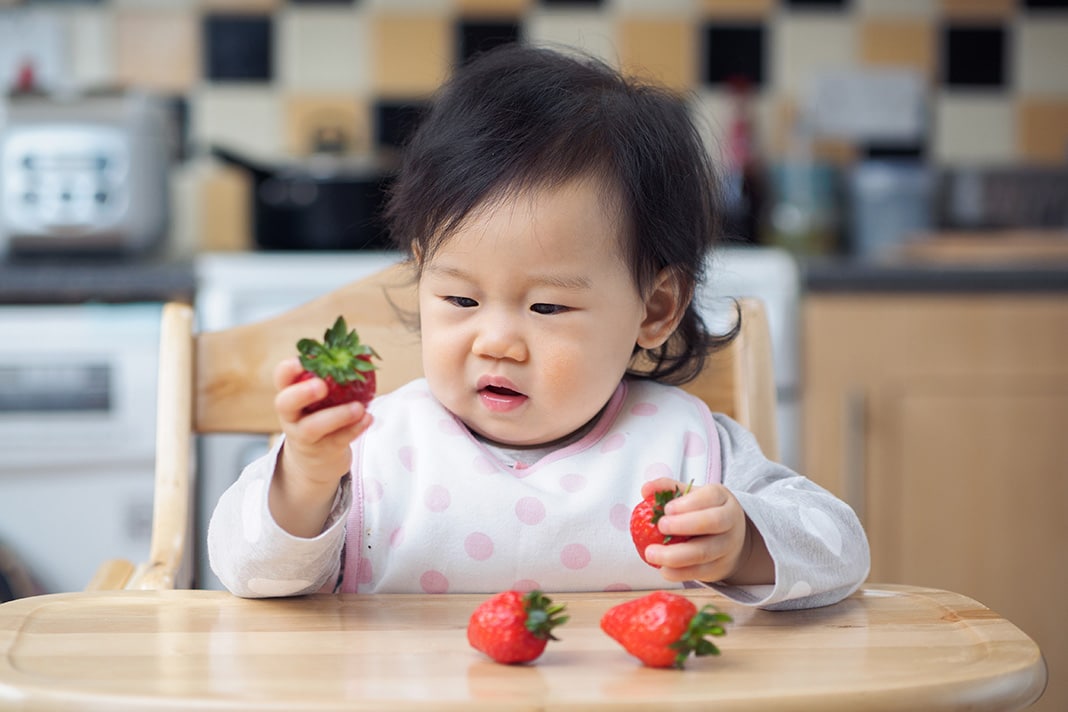The idea of baby led weaning is growing in popularity. Food expert Annabel Karmel provides her tips for those wanting to try it
Words Miriam Carey
The idea of trying baby-led weaning (BLW) can make some parents nervous: giving babies of such a young age whole pieces of food and control over their own eating can be quite frightening, for a start. Questions like ‘what if my baby chokes’ and ‘will my baby get enough nutrients’ are common among parents thinking about going down this path.
Despite all this, the idea of baby-led weaning has been growing in popularity over recent years. Many people assert that BLW encourages good eating habits for the future, and that exposing little ones to a variety of tastes and textures from a young age encourages healthy eating.
Also, having everyone sitting around the table at once sharing the same food promotes the principle of social eating.
If you’re considering trying BLW, baby food guru Annabel Karmel has just released a book on the subject which contains lots of great recipes and helpful tips for mothers who want to try this option, including the fact that you don’t have to go full-fat BLW; you can mix it and match with the puree option.
Below are some tips from Annabel’s book, to encourage you along the way if you’re keen to give baby-led weaning a go.
There is no right or wrong way of weaning
Babies should be given breast or formula milk for the entire first year and they will gradually consume less in favour of solid foods. Between six months and one year babies will still need 500-600ml of breast milk or formula each day.
There is no correct way of introducing solid foods. The right way is to do whatever feels best and go at your baby’s own pace. Variety is good, it is okay to use a combination of both puree and allowing your baby to explore at meals times, and keep feeding milk all of first year.
There is often some concern about whether allowing your baby to eat by themselves can cause choking. Whatever method you go for babies should always be held upright when they are eating and never be left alone. Allowing your baby to go at the own pace is the number one step to reduce the risk of choking.
How do you know when your baby is ready to start?
It is important to follow what feels intuitive for you and your baby. Some clues your baby is ready to experiment with weaning could include she is able to sit up unassisted and has the hand eye co-ordination to pick up food and put it in her mouth. She has lost her tongue-thrust reflex and is able to chew. And most importantly that she is showing interest in joining in at family mealtimes.
Top baby-led weaning tips
- Don’t overwhelm your baby with too many food options at the beginning. Just a couple of pieces of food or a small portion of a family meal will be adequate.
- Let your baby pick up the food with her fingers. This will help her learn to move food safely around her mouth and ensure she only puts in what she can manage.
- Make sure the pieces aren’t too wide so babies can get there hands around them. 5-6cm batons of steamed carrots, roasted sweet potato, or banana is a good estimate.
- Chicken curry, quesadillas, fishcakes and mini burgers are all good examples of meals that can be enjoyed by baby and the whole family. Recipes for these can be found in Annabel’s book.
- A crinkle cutter is a good baby-led weaning buy. Use it to cut up fruit and vegetables -the ridges will make it easier for your baby to grip the food and even more fun to chew on!
- Baby-led weaning can get messy so invest in a wipe-clean bib and a splash mat for the floor. Shower curtains are a great cheap, reusable option.
- A crinkle cutter is a good baby-led weaning buy. Use it to cut up fruit and vegetables -the ridges will make it easier for your baby to grip the food and even more fun to chew on.
Visit Annabel’s website and order one of her books at Annabelkarmel.com
Read more like this at Absolutely-mama.co.uk






NO COMMENT